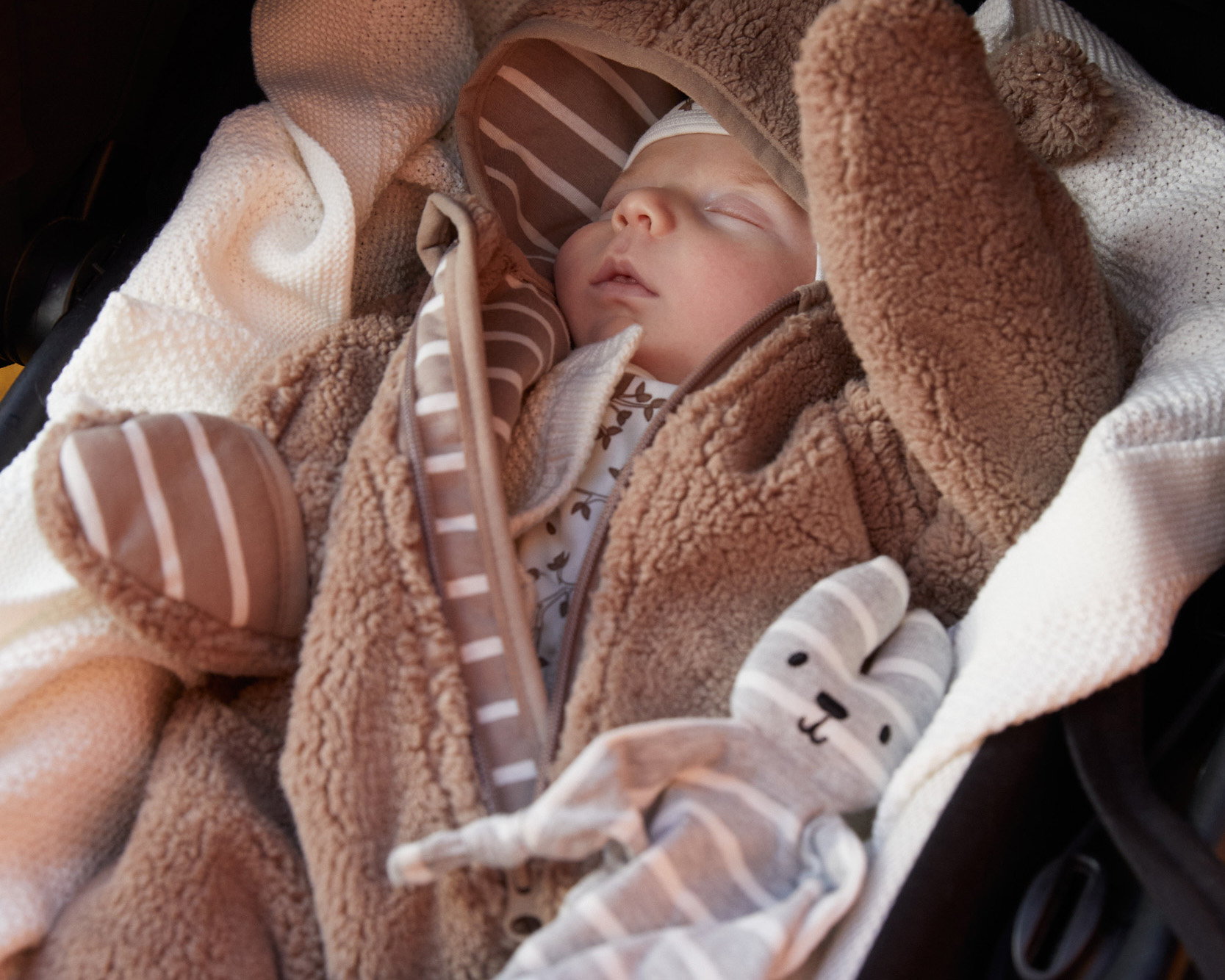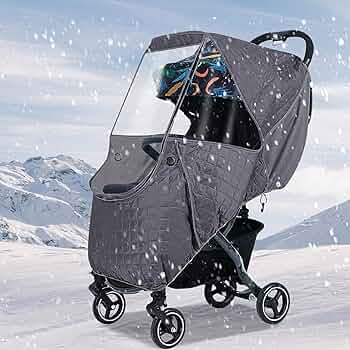Your baby’s cheeks turn pink as you bundle them into the stroller for a winter walk. You’ve layered their outfit, but within minutes, their tiny hands feel icy—a silent alarm that your warmth strategy isn’t working. Babies lose heat four times faster than adults and can’t shiver to generate warmth, making proper stroller insulation non-negotiable. This guide reveals exactly how to dress your baby, select critical gear, and recognize dangerous cold stress signs before frostbite or hypothermia strikes.
Most parents overestimate how much clothing babies need, leading to dangerous overheating or under-dressing. The truth? Dress your baby in just one more layer than you’re wearing—not two or three. A cotton sleeper base layer, fleece mid-layer, and windproof outer shell create safer, more effective warmth than bulky snowsuits. You’ll learn the precise temperature limits for stroller outings, how to install life-saving footmuffs, and why checking your baby’s neck—not their hands—tells you if they’re truly warm.
Why 20°F Is Your Absolute Stroller Temperature Limit
Never push your stroller outside when temperatures drop below 20°F (-7°C) for more than 15 minutes. At this extreme cold, frostbite can develop on exposed skin in under 30 minutes—especially on delicate fingers, toes, and cheeks. Wind chill makes this threshold even more critical: A 25°F day with 15mph winds feels like 10°F, requiring immediate precautions.
How Wind Chill Dictates Your Walk Duration
- 30°F (-1°C) and above: Safe for extended walks (45+ minutes) with proper layering
- 20-30°F range: Limit stroller time to 20 minutes max, even with full insulation
- Below 20°F: Cancel outings entirely unless absolutely necessary—then cap at 15 minutes
Critical mistake to avoid: Relying solely on thermometer readings. Always check the “feels like” temperature on weather apps. If wind chill pushes conditions below 20°F, head indoors immediately if your baby shows early cold stress signs like a cold neck or floppy movements.
The 3-Layer Dressing System That Actually Warms Stroller Babies

Generic advice like “dress warmly” fails because babies overheat or chill rapidly. This science-backed layering sequence traps body heat without restricting blood flow—a leading cause of dangerous cold exposure.
Base Layer: The Non-Negotiable Foundation
Start with a cotton sleeper with footies and built-in mitten cuffs. This breathable layer wicks moisture while keeping core warmth close to your baby’s skin. Ensure it fits snugly but never pinches—restricted blood flow makes extremities colder. Skip cotton socks; they retain moisture. Instead, use wool socks under booties for dry warmth.
Mid-Layer: The Insulation Powerhouse
Add fleece footie pajamas or a long-sleeved shirt/pants combo. This layer creates air pockets that trap heat without bulk. Size up slightly to accommodate the base layer—tight mid-layers compress insulation and reduce warmth by 40%. For temperatures below 25°F, switch to fleece pajamas as your mid-layer; their tighter weave blocks wind better than cotton.
Outer Layer: Windproof Defense for Stroller Rides
For 25-30°F: Use a Sherpa-lined jacket with hood or one-piece fleece bunting. Below 25°F: Opt for a water-resistant winter coat and snow pants with built-in mitten cuffs. Prioritize:
– Windproof outer shell (nylon/polyester blend)
– Machine-washable materials (critical for spit-up emergencies)
– Secure chin straps on hats—never ties that loosen
Pro tip: Test layers indoors first. If your baby’s neck feels sweaty after 10 minutes of play, remove the mid-layer. Overheating causes rapid cooling when you step outside.
Must-Have Stroller Insulation Gear for Sub-30°F Weather

Blankets alone won’t cut it when temperatures drop. These three gear categories create a mobile warmth cocoon that blocks wind while allowing ventilation.
Footmuff Installation That Prevents Frostbite
A quality footmuff (like a sleeping bag for strollers) zips around your baby and attaches to harness straps. Choose wool or down fill with a wind-resistant shell—synthetic Sherpa loses 60% of its insulating power when wet. Verify universal fit for your stroller model before buying. Install it by:
1. Laying the footmuff flat in the stroller seat
2. Positioning harness straps through designated openings
3. Securing the top flap over your baby’s chest (never over their face)
Safety note: Never use a footmuff with thick harness padding—it creates dangerous slack. Test harness tightness by ensuring only two fingers fit flat against your baby’s chest.
Weather Covers: Your Windproof Barrier

Insulated winter covers outperform standard blankets by sealing out wind while venting moisture. For temperatures below 25°F, use a double-layer cover with zippered ventilation panels. Attach it by:
– Securing the bottom edge under stroller wheels
– Fastening side snaps tightly to prevent flapping
– Leaving the top 6 inches unzipped for airflow
Critical mistake: Covering your baby’s face. Always position covers below chin level and check every 5 minutes for condensation buildup.
The 6-Step Pre-Walk Checklist for Cold Stroller Safety
Skipping these steps risks dangerous cold exposure. Complete this routine before every winter outing:
- Verify wind chill—not just temperature—using your weather app
- Test all layers for proper fit (no constricting seams on wrists/ankles)
- Apply Vaseline or Aquaphor to cheeks, nose, and lips (prevents windburn)
- Install footmuff and cover, then test harness security
- Pack backup mittens and blankets in your diaper bag
- Map indoor warm-up spots along your route (libraries, coffee shops)
During walks, check your baby’s neck temperature every 10 minutes. If it feels cold, add a blanket immediately. Never rely on hand temperature—cold hands are normal, but a cold neck means core chilling.
5 Silent Cold Stress Signs in Stroller Babies (You Can’t Ignore)
Babies can’t verbalize coldness, so watch for these subtle indicators:
Early warning signs (act immediately):
– Cold tummy, back, or neck when touched
– Unusually still or floppy body movements
– Poor feeding interest when you pause for a snack
Danger signals (head indoors NOW):
– Shallow, slow breathing
– Blue or pale skin on lips/face
– Limp limbs that don’t resist movement
Frostbite progression: Starts with red skin → turns white/grey → feels hard/cold → develops purple/black discoloration. If you see white spots on ears or nose, rub the area gently with warm (not hot) hands and seek medical help.
How to Keep Mittens On During Stroller Walks: Real Solutions
Mitten removal is inevitable—babies’ fine motor skills develop before they understand cold risks. Instead of fighting:
- Layer two pairs: Thin cotton mittens under thick fleece ones
- Use footmuff sleeves: Tuck hands into the footmuff’s arm holes for wind protection
- For toddlers: Allow 2-minute “hand freedom” bursts during active play, then re-mitten
Never secure mittens with strings—they pose strangulation risks. Velcro wrist cuffs on sleepers work safest for newborns.
Babywearing vs Stroller: When to Switch in Extreme Cold

When temperatures drop below 25°F, babywearing transfers your body heat 3x more efficiently than stroller insulation. Use this strategy:
- Reduce baby’s layers by one (e.g., skip the mid-layer)
- Wear a babywearing coat with extension panels or use a fleece carrier cover
- Position baby skin-to-skin against your chest for severe cold snaps
This method works best for errands under 20 minutes. For longer outings, alternate: 10 minutes babywearing → 10 minutes in a fully insulated stroller.
Monthly Stroller Warmth Gear Checks That Prevent Frostbite
Your gear degrades faster than you realize. Perform these checks:
- Footmuff straps: Replace if frayed—loose harnesses cause dangerous shifting
- Weatherproofing: Spray DWR (durable water repellent) on covers when water stops beading
- Blanket anchors: Sew loops to secure blanket edges (prevents throwing)
- Size upgrades: Move to larger footmuffs monthly—tight gear restricts blood flow
Pro tip: Keep a “winter stroller kit” by your door with backup mittens, Vaseline, and a thermometer. No more frantic searches when the weather shifts!
Keeping your baby warm in the stroller isn’t about piling on layers—it’s strategic insulation. Start with the 3-layer dressing system, install a windproof footmuff, and never exceed temperature limits. The moment you feel doubt about their warmth, head indoors. Your baby’s safety always trumps finishing the walk. When you master these protocols, winter outings transform from stressful sprints to joyful family adventures—even when the thermometer drops.





